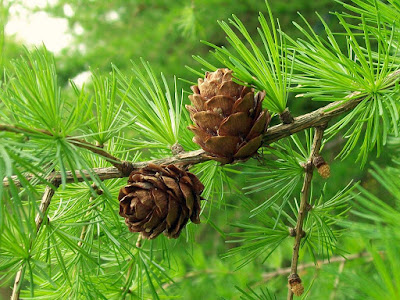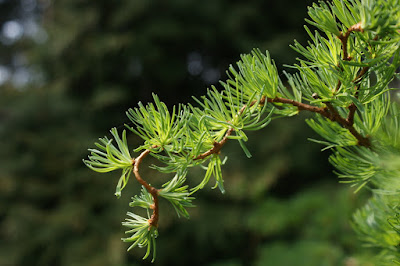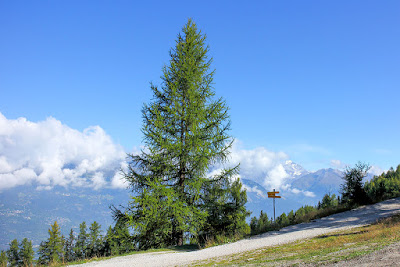Larix decidua is endemic to Europe, occurring naturally across central Europe from the Alps in eastern France, through the Carpathian and Slovenian mountains, to southern Poland, western Ukraine and northern Romania. It grows in the high mountains at altitudes between 1000 to 2200 meters above sea level. It is very cold tolerant, able to survive winter temperatures down to at least -50 °C and is hardy to USDA Hardiness Zone 3 to 6.
Larix decidua also called as European Larch, is a species of the genus Larix. This species was described by Philip Miller in 1768.
IDENTIFY LARIX DECIDUA - EUROPEAN LARCH PLANTS
Larix decidua is endemic to Europe, occurring naturally across central Europe from the Alps in eastern France, through the Carpathian and Slovenian mountains, to southern Poland, western Ukraine and northern Romania. It grows in the high mountains at altitudes between 1000 to 2200 meters above sea level. It is very cold tolerant, able to survive winter temperatures down to at least -50 °C and is hardy to USDA Hardiness Zone 3 to 6.
European Larch is a deciduous coniferous tree which reaching up to 50 m tall with to 2 m in diameter trunk that has grayish brown bark and irregularly pyramidal crown. The long branchlets are light yellow or light grayish yellow (turning gray or blackish in 2nd or 3rd year). The short branchlets bearing rings of scale remnants. The leaves are 2-3 cm x 0.5-1 mm, light green (turn bright yellow before they fall in the autumn). The seed cones are dark red or purplish, becoming green with pink scale margins. The seed are dark brownish gray.
This larch is cultivated as an ornamental tree for planting in gardens and parks. Their wood is valued for its durability and has been used to build houses, fences, gates... The bark has been used as an astringent, balsamic, diuretic, expectorant, stimulant and to treat wounds, and to treat eczema and psoriasis). Resin is extracted and used directly (dried and powdered), and also used to produce turpentine.
LARIX DECIDUA - EUROPEAN LARCH PLANTS CARE AND CULTIVATION
The cultivation of these plants presents no special difficulties, if proper soil and exposure are available. The question of hardiness is, of course, all-important. It is not only the problem of temperature the given tree will stand, but also the exposure to winds, and, to a considerable extent, the source from which the tree is derived. If the plants are raised from seeds matured in similar or even more rigorous climates, they are usually more hardy.
Soils:
Larix decidua prefer a well-drained porous gravelly subsoil, overlaid with a light sandy loam. They seem to be particularly happy in a soil underlaid with a porous glacial drift. In cultivation, however, they succeed very well in ordinary well-drained soil. When the plants are set in clay soil, which is often done, the soil should be thoroughly loosened by trenching or subsoil plowing, and well underdrained. Any available humus, woodashes, and well-rotted manure incorporated in the soil greatly aid in rendering it friable and porous for the roots.
Manures and mulches:
Mulching with ordinary well-rotted barnyard manure in late autumn affords much stimulus to growth. By the following spring the manure will be in a desiccated condition and can be incorporated with the soil. A heavy mulch of old straw, rotten hay, or any similar material over the roots, and this was maintained throughout the entire growing season is benefit to the plants in a more or less juvenile condition.
In many cases manure is not obtainable. In such event, newly moved plants should be heavily mulched with rotten straw, rotten hay, or any similar rubbish for a few years until they become established. The frequent stirring of the ground over the roots subsequently will conserve sufficient moisture.
An area extending from the stem to one to two feet beyond the branches, stirred up with hoe and rake perhaps five or six times throughout the growing season, is very beneficial in conserving the moisture around the roots.
Pruning:
Removal of the lower branches of European Larch is a serious mistake, and, if healthy, they should be retained to the base. Pruning or disbudding can be intelligently performed to add much to the natural symmetry. The extraction or removal, early in spring, of the central or terminal bud, will tend to compel the branches which start from the side buds to spread apart and form a much denser growth. Cutting back the previous year's terminal growth to a strong bud or branchlet on the main limbs over the tree, if the plant is inclined to be thin in its branching, always produces a much denser lateral growth.
Transplanting:
Transplanting can be done at all times of the year, excepting midsummer when they are in full growth. The best success is secured in spring when the buds begin to swell. From the end of August to the middle of September, if there have been abundant rains and the ground has been well soaked, is a very good time to move the plants. They may be planted late in autumn when circumstances compel it, but there is likely to be a considerable percentage of loss. Their roots are very susceptible to injury from exposure to the air, and the utmost vigilance should be exercised to keep them covered and moist.

















COMMENTS